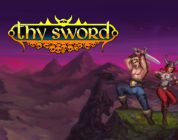In the land of Mordor, where the shadows lie, a Ranger and a Wraith set out on a path of vengeance against the Black Hand, a lieutenant of the Dark Lord Sauron. The Ranger, Talion, was killed by the Black Hand after watching his wife and son sacrificed before him as part of a dark ritual. The Wraith, whose identity will be discussed later in the review (I’d say “spoiler alert,” but WB already came out and spoiled it through trailers, which is another thing I’ll get to), enters Talion’s body, resurrecting him and granting him extraordinary abilities, though he is unable to remember his identity or history.
The most difficult hurdle that any licensed game has set in front of it is the same thing that makes it so very desirable and marketable: the license. There are only a few licensed games that truly stand out in my memory as enjoyable, or even passable, and even fewer that struck me as truly excellent. Too often, licensed games are merely an afterthought, or an attempt to cash in on the popularity of the source material. This results in, more often than not, two negatives: a bad game and angry fans of the source.
Middle-Earth: Shadow of Mordor is neither an afterthought nor a cash-grab; it is an incredibly well developed game with a connection to Tolkien’s world that hits more than it misses (though the misses could be seen as…foundational). I’m going to keep my commentary on the Tolkien connection to as low a level of pedantry as I can. Tolkien’s Middle-Earth (and, by extension, Arda) stands in a class of its own in my estimation; I read The Hobbit, The Lord of the Rings, and The Silmarillion before I hit double digits, with countless rereads in the years following.
That said, gameplay first! If you’ve played either Assassin’s Creed or the Batman: Arkham series (or both), you should be pretty familiar with most of movement and combat, respectively. Talion’s free-running ability is very reminiscent of the Assassins, as is his ability to stealth kill an enemy while hanging on a ledge and his ability to leap down onto an unsuspecting enemy sword first. In group combat, Talion feels faster than Batman, but the same basic principles apply. Attacks chain into high combo multipliers which, later on, allow you to use special attacks. The counter, dodge, and leap systems are all just where you’d expect them, too. This makes combat just as fluid and entertaining as it is in the Arkhams, and that’s not a bad thing.
As with the Assassin’s Creed series, the map is divided into multiple regions. Each specific region, however, is part of a larger cohesive area. The entire map is accessible, but finding the larger cohesive area’s Forge Tower and “reforging” it opens up map details, such as collectible locations and more. The world is alive, and side missions are always popping up, so you can quite easily spend a great deal of time not progressing the main story, but still progressing Talion. However, as with the Assassin’s Creed series, the movement mechanics get a little wonky when you’re sticking to cover. Talion gets a bit too sticky, at the worst possible times. There’s less in the way, though, in general, so it doesn’t become an issue nearly as often as it does in the Assassin’s Creed franchise.
Talion doesn’t unlock new weapons or armors in the game. Rather, he upgrades by acquiring runes that can be applied to his weapons and by spending points/currency to improve his (and the Wraith’s) abilities. Runes are found by defeating orc Captains, and are quite diverse in their effects, while the ability upgrades and unlocks make some really interesting elements available. Currency unlocks health and focus improvements, as well as extra arrows and rune slots on the sword, dagger, and bow. These are progressive, and only limited by the amount of currency you have. Real abilities are unlocked through ability points, and are set up on a tier system. This is where Shadow of Mordor blends the main story missions with the rest of the game world, as every tier beyond the first must be unlocked through a combination of story missions and side missions.
As I said earlier, Talion shares his undead body with a Wraith, gaining extraordinary abilities. One of these unlockable abilities, which becomes central to the plot, is the ability to dominate the minds of orcs and other creatures. These orcs will fight for you and, perhaps more importantly, bring you intel on the other Captains and the Warchiefs. Intel is your friend. Intel can save your life.
There are twenty Captain slots. When you kill a Captain, another orc will eventually step up to take its place. Beyond the twenty Captains are the five Warchiefs, who serve as an inner circle to the primary antagonist. The twenty Captains (and five Warchiefs) are shadowed out until you either: a) encounter one, b) find intel, c) interrogate a random orc, or d) interrogate a worm (special orc) or other Captain. A and C result in the name and location only, while B and D provide name, location, strengths, and weaknesses. These strengths and weaknesses can be vital to how you approach and combat a Captain or Warchief. In this video, for example, I was aware that Goroth’s weaknesses included a crippling fear of caragors, vicious beasts similar to wargs. By riding one, and by releasing one adjacent to him, I counteracted some of his strengths, and made him an easier kill. Some are immune to ranged weapons, some are immune to sneaking, some are afraid of fire, some become enraged when damaged (making them angrier), and some can track you. The list is expansive and diverse, introducing an element of strategy into each of your battles.
And let’s say, in spite of this intel, you lose to your opponent Captain? Or hell, maybe you beat him to the point where he flees, or, y’know…dies. Enter the Nemesis system. Enemies remember you, whether you ran or you hurt them severely in the past. It colors how they react to you. I fled a massive grouping of orc Captains, and as I confronted each of them individually later on, they teased me in different ways about my “cowardice.” I slaughtered them and laughed over their remains. One that I killed respawned somewhere and, when confronted again, commented on how I left it for dead, fighting me more ferociously than before. Each time you lose to a Captain, or allow a world event (power struggle between two Captains, an ambush, a test of strength, etc.) to be completed successfully without interfering, the Captain involved gains a power level. This makes him a more lucrative kill later, of course, but it also makes him more difficult.
So, y’know, the game itself is really, really, ridiculously fun.
But how is the story? Does it make you want to play the game to its end? Does it keep you invested in progressing? Does it fit within Tolkien’s established world?
Great. Yes. Yes. Mostly.
On its own, Shadow of Mordor has a great story: two lost souls (swimming in a fish bowl) bound by a common pain and a common enemy seeking vengeance and a release from a cursed existence. We know everything about Talion already, but who is the Wraith? A string of quests provided by an absolutely precious established character slowly peels the layers of his identity through a series of object-triggered visions into the past. Even setting aside the main story to go on a rampage against the Captains helps destabilize the enemy, which helps the main story. The game knows how to keep you hooked.
Does it fit within Tolkien’s established world? Click here to find out. The review had pushed past 2,000 words with ease, so I cut this section out and let it stand on its own.
There are a few notes to make. First, the previous-gen versions (PS3/360) of the game will have a reduced/limited Nemesis system, due to the lower capabilities of the platforms. The game was designed primarily for the current-gen systems (PS4/XBO), and it is on the current-gen systems that the full experience can be found. Second, Middle-Earth: Shadow of Mordor has a companion app for the iPad (and only the iPad, which is very disappointing) called Palantir. Accessing the Palantir after signing in to the game with your WBID will grant you the Gravewalker Rune, which will “spread fear among Sauron’s army when his Captains are defeated.” Pretty snazzy, but if you don’t have an iPad, you’re not getting it. Thirdly, the game will have a $24.99 Season Pass. The Season Pass will include an exclusive mission (which results in an exclusive rune), the Trials of War (which include the Test of Speed, Test of Wisdom, and Endless Challenge modes), and additional unannounced content. Fourthly, the PS4 version of the game comes with two additional exclusive missions: Blood Hunters and Flesh Burners, both of which, again, result in exclusive runes.
So, the gameplay is (mostly) wonderful (and familiar), fantastic new systems are introduced to keep the world engaged and evolving, and the story is both entertaining and non-contradictory to the source material. It’s my favorite game so far this year, and though Platinum Games is releasing two titles this month (I’ve made no secret of my love of Platinum Games), I have no doubt that it will prove strong competition to close out the calendar. Middle-Earth: Shadow of Mordor, simply put, is an excellent game, and far and away the best Lord of the Rings title yet.





